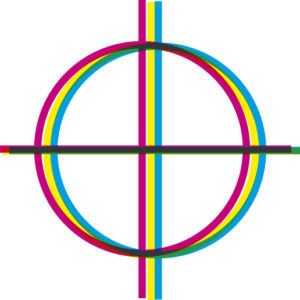
Trapping is the process of overlapping two inks (whether spot or process CMYK) into each other eliminating misregistration of colours on the printing press. Look very closely and you’ll see it everywhere on printed material. The golden rule is that the darker colour holds its shape and the lighter colour ‘traps’ into that shape. Trapping avoids any white shapes showing in between colours when inks are slightly out of register. ‘Registration’ is making sure each ink sits exactly over the top of each other and that each ink is registered with each other.
Trapping amounts vary depending on the quality of the printing press, the substrate or paper stocks used and the speed of the printing press. The faster the speed the more chance of the inks falling out of registration with each other as the sheets move through the press. It can be as thin as strokes 0.2 of a millimeter or as thick as 2mm. Your printer will set their preferred trapping amounts.

The Registration marks hidden in the flaps of packaging show the accuracy of the print work and whether any colours are out of line with each other.
Use a Lupe magnifying glass to really get a good look. Printers usually have swatches of Spot and Process colours near them so they can check the colour accuracy of the inks as well.

This example shows the misregistered blue ink leaving a white gap from the grey shape.
Printers eliminate this by trapping one colour into another. When inks are not trapped into one other they are called ‘butting’ colours (where one colours butts against another).

One solution (particularly for very fine type) is to ‘overprint’ the grey onto the blue background.
This eliminates any white ‘ghosting’ that may occur but does change the colour of the overprinting colour as it adds the base colour to the top colour.

Overprinting cannot be avoided with very small text.
The trapping amount would create a visually distracting effect and basically replicates the effect of overprinting.

Correct trapping of the blue into the grey shape allows the main shape to show through from the background.
It eliminates any chance of white paper showing if the printing plates are out of register and is as unnoticeable as possible to anybody looking at the printed piece.
Although trapping is usually the domain of printers and Pre Press houses it is an important element for Graphic Designers to consider when designing printed material since it will change the colours of artwork if darker colours need to be overprinted on lighter colours or effects like white keyline strokes are needed to stop colors butting or trapping together.
Things to remember:
- Darker colours hold their shape.
- Light Colours spread under (choke) darker colours.
- Spot PMS colours will always need trapping into Process CMYK colours.
- Metallic Inks are opaque so all other inks will choke under them.